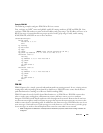To minimize the repeated flooding of datagrams and subsequent pruning associated with a particular
source-group (S,G) pair, PIM-DM uses a State Refresh message. This message is sent by the router(s)
directly connected to the source and is propagated throughout the network. When received by a router
on its RPF interface, the State Refresh message causes an existing prune state to be refreshed. State
Refresh messages are generated periodically by the router directly attached to the source.
PIM-DM is appropriate for:
• Densely distributed receivers
• A ratio of few senders-to-many receivers (due to frequent flooding)
• High volume of multicast traffic
• Constant stream of traffic
Example: PIM-DM
The following example configures PIM-DM for IPv4 on a router.
First, configure an OSPF
1
router and globally enable IP routing, multicast, IGMP, and PIM-DM. Next,
enable routing, IGMP, PIM-DM, and OSPF on one more interfaces.
console#configure
router ospf
router-id 3.3.1.1
exit
ip routing
ip multicast
ip igmp
ip pimdm
interface vlan 1
routing
ip address 3.3.3.1 255.255.255.0
ip pimdm
ip igmp
ip ospf area 0
exit
interface vlan 3
routing
ip address 1.1.1.1 255.255.255.0
ip pimdm
ip igmp
ip ospf area 0
exit
exit
1. OSPF configuration is added as a unicast protocol for illustration purposes; static unicast routing could also be
configured.


















